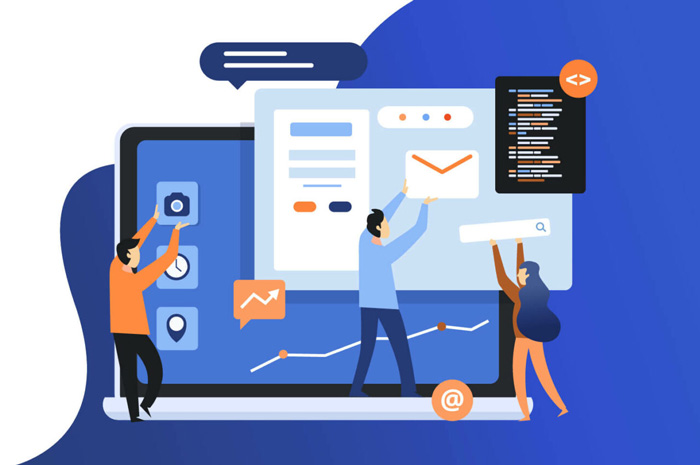If you have decided to redesign a website or just have an idea, I recommend reading this article. Maybe you’ve noticed that your website is looking outdated and decided it’s time to update it, or maybe you’re trying to get visitors to your website or convert them into customers and want to change it.
No matter why you want to change the design of your website, experience shows that it can solve many problems. But if something goes wrong, it can completely destroy your business.
In fact, we believe that whatever is good for our customers is good for our business. In this article, we’ll start with a key principle: when it comes to redesign a website, the best, safest, and most effective approach is as close to the client’s needs as possible.
What is the difference between a website update and redesign a website?
It’s a good idea to check the draft first to make sure you’re in the right place. Whether you’re redesigning or updating your website depends on how many changes you’ve made in the process. Redesigning websites often involves major changes to coding and appearance.
Along with, for example, implementing a new brand and visual identity, redesigning pages with UX or smart user experience to include modules and new features, updating the information architecture of the information structure, and launching a new CMS. it is possible.
Updating a website means making only minor changes while maintaining the basic structure and functionality of the website. For example, a website design can be updated with a new color scheme and typography, or simple UX techniques can be added to a single page template.
redesign a websites and website updates can be divided into two different categories, but they all have some important things in common – they both have a significant impact on your customers and how they interact with your website.
At the end of the day, it doesn’t matter if you’re redesigning or updating your website; the most important thing is how you behave. It all starts with a few simple questions.
5 questions we need to answer before and during our website redesign
The process of redesigning your website should include thorough research. The best way to determine which components work and which don’t is to do it. When you decide to redesign a website and actually get started, you should consider and answer the following questions about your website and your target audience:
- Which pages are most valuable to you?
- Who is viewing your site and why?
- What specific customer needs are not being met by the current website and what is preventing them from meeting those needs?
- How has the website redesign affected your team and your business?
- How can you use Key Performance Indicators (KPIs) to measure the success of redesign a website?
Don’t worry if you can’t answer these questions right away. We’ll categorize and describe them in the rest of this article so you can be sure you’re redesigning your website for the right reasons and using the most effective strategies.
1. Which pages on your site are the most valuable?
One way to do this is to study the relationship between traffic and conversion rates. Each page on your website falls into one of the 4 categories below based on the correlation between traffic and conversion rate.
High converting and high traffic pages
The most important pages for your business are the ones with high conversion rates and high traffic, so you should treat them carefully and ten times more carefully than anything else you convert.
Low traffic, high converting pages
These pages are important for the conversions they generate. Care must be taken not to interrupt this flow when redesigning a website, even if they do not currently have much traffic.
Pages with low conversions and high traffic
Began the redesign a website with the goal of improvement, recognizing that this redesign was less risky and more open than the previous two redesigns. Pages with high traffic and low conversion rates These pages have a lot of traffic, but it doesn’t make sense!
Low-converting, low-traffic pages
Due to their low traffic, changes to these pages will be barely noticed and are not considered risky conversions, so make sure to modify as many of these pages as possible on your site to be safe.
2. Who visits your site and why?
As I said, finding the most valuable pages is one of the most overlooked aspects of a redesign a website, but it’s only half the battle; you also need to know who is visiting your site and why.
In this case, users can inform your website:
- They are interested in learning more about your company and products.
- They want to talk to you and maybe even find you.
- They want to learn how to work with one of your products.
- They want to buy you something.
Of course, there are many other reasons for visiting a website, and you need to consider the needs of your target audience when redesigning your website.
In other words, you first need to understand why customers visit your website. By developing customer personas, you can get to know them. What does it mean? Create a story that includes your current and ideal customers.
3. What hinders or motivates your customers to continue?
Knowing which of your pages are the most valuable, who is visiting them, and why is a good starting point for redesigning your site, but it’s certainly not enough to create successful pages. There are currently two major gaps in your knowledge:
What convinces customers, makes tasks easier and keeps them on track.
That’s why we’ve divided our factors into two groups: “blockers” and “blockers” that your customers may encounter on your site. By exploring obstacles and obstacles, you will be able to see exactly what:
- A place where people stop and get stuck.
- On each page, what works well and what doesn’t.
- What users like or dislike about each experience.
- After all, these are the things that make you disappointed and doubt yourself.
4. How has the redesign affected your team?
When you’re ready, tell your teammates about your new plan instead of announcing it. Everyone who interacts with your website, including your customers, needs to be aware of any changes as they affect every aspect of your business. To show:
- In addition to ensuring that UX web design is not compromised, design and UX teams must have a clear understanding of what design elements need to be added or changed.
- Content creation and copy writing teams need to know where the content will appear and how much space is available for editing in order to decide on new and edited versions.
- To ensure current rankings are maintained post-launch, SEO and development teams need to pay close attention to the technical aspects of redesign a website, including possible URL migrations.
- Sellers should be familiar with the updated structure and can use the site to achieve key sales goals.
- Customers looking for information or trying to solve a problem need advice from a support specialist who knows where to look and what to do.
5. How will the Key Performance Indicators (KPIs) be measured?
If you’re running an online-only business, the most accurate way to know if a change was successful is to use net profit. At first glance, you will quickly understand: would redesign a website be good for your business?
A website redesign can impact the sales figures needed to create a website that your audience likes and uses to make purchases. These standards include:
- Convert amounts.
- currency exchange.
- Income.
- Average order value (AOV).
- Customer Lifetime Value (CLV).
The effectiveness of the website conversion can also be evaluated according to qualitative criteria. To show:
- Have the number of support requests or messages decreased since redesign a website?
- Customer Satisfaction Score (CSAT) – Has it increased? – Are customers more satisfied with some aspects of your service, including support?
- Has the new website version improved your net advertising results?
- According to Customer Effort Score (CES), one of the goals of the redesign was to make the site easier to use. Are your website users more comfortable now?
A final word on website redesign services
A website redesign is never really done, and your work will continue after redesign a website. Customer preferences, browser upgrades, design practices and standards are constantly evolving.
Components that were available at the time of the redesign may not be available for years. You have to keep up with the needs of the customers. After all, this site was created with them in mind!




